2006 CAARMS12
CAARMS1
June 1995 at the
Mathematical Sciences Research Institute (Berkeley, CA)
|
2006 CAARMS12 |
|||
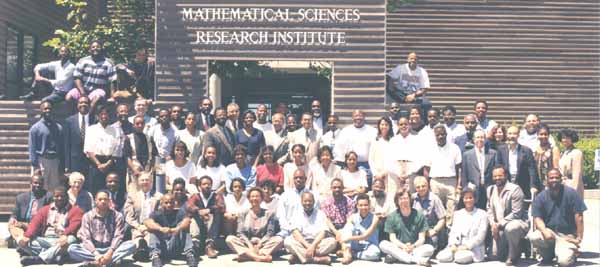
The Conference for African Americans in the Mathematical Sciences
Report by Raymond Johnson published in Notices of the AMS, December 1995
How This Conference Came to Be
Abstracts of Presentations at the Conference
The Council and other conferences for African American Researchers in the Mathematical Sciences
Official Webpage of the Conference
![]()
REPORT by Raymond Johnson
Forty-one mathematicians interested in the development of mathematics among African Americans and other minorities gathered at MSRI in Berkeley on June 21-23, 1995, for a mathematics conference. They were joined by thirty-eight undergraduate and graduate students, whose perspective was sought on critical issues facing the profession. The conference was funded by MSRI, AT&T Bell Laboratories, and the Department of Energy. Since interest in mathematics was the common bond for participants, the bulk of the conference was devoted to talks in a variety of areas such as differential geometry, dynamical systems, mathematical biology, astrophysics, and numerical analysis. However, discussions on how to overcome the barriers to participation in mathematics by minorities played a central and vigorous role.
One can ask the same questions about this conference that Lenore Blum asked in her description of the Women in Algebraic Geometry Workshop (Notices, 40, 7, September 1993, pp. 860-861) and give the same answers plus one. I paraphrase Lenore's question: ``Clearly such a workshop would be a stimulating and worthwhile experience for any budding research mathematician; and so the question arises, why have a special program for [African Americans]? Is it because [African Americans] have to learn mathematics in a special way? To the contrary, it is to create an environment where [African Americans] have a chance to do and learn mathematics in a way that most successful [white] male mathematicians take for granted.''
The difficulty of doing this is compounded for many African American mathematicians by the fact that they are frequently isolated in their home environments. Many have overcome this isolation by establishing networks of collaborators and contacts outside their home institutions. This conference allowed them to extend those contacts and offered graduate and undergraduate students an opportunity to begin that process.
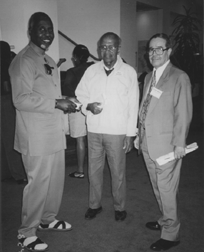
Abdulalim A. Shabazz,
David Blackwell ,
and J. Ernest Wilkins,Jr.
in 1995
Another benefit was to show the students that there is a community of African American researchers to which they can aspire to belong and from which they can receive advice and support. The conference benefited greatly from the participation of David Blackwell, the first African American elected to the National Academy of Sciences and still the only African American member in mathematics, and J. Ernest Wilkins, member of the National Academy of Engineering. Many people commented that they never knew that there were so many people like themselves who were interested in mathematics. (Besides those listed at the end of the article, another twenty-eight senior participants were invited but were unable to attend the conference and forty-eight additional students were identified, but funds did not permit the invitation of all.)
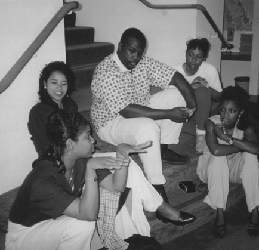
left to right: Dawn Lott-Crumpler, Tasha Inniss, Darryl Corey,
Flory Holmes, and Willette Johnson
We are a small community and this limited our ability to specialize. The talks necessarily covered a wide spectrum of mathematics, but, as Bill Massey points out, it is important for researchers to be able to communicate their mathematical ideas ``outside'' their specific research community. Each talk (whether by experienced or beginning mathematicians) was carefully prepared, expertly and confidently delivered, and heard by a very attentive audience. Speakers took seriously the injunction to make talks accessible to nonspecialists, and all talks were followed by extensive discussion.
The format was unusual for a mathematics conference, in that discussions of issues affecting mathematics were planned along with the mathematics talks. Mathematics talks were scheduled from 9-4 each day (four talks/day), with discussion on some topic scheduled each afternoon from 4-6. The first day we discussed concrete steps that can be taken to increase the number of African American researchers. Bob Megginson noted that the problems blocking increased participation in mathematics by Native Americans were similar to those being discussed that affected African Americans.
The second day we discussed steps in developing a career in research, including the central role of racism as an obstacle to opportunity and welcome--two prerequisites to success. In 1995 the problems remain surprisingly unchanged from thirty years ago. However, in 1965 there was a vigorous civil rights movement challenging society and academe. Today equal opportunity is under attack; the critical importance of this battle and our need to make alliances with and support community groups engaging in the struggle to extend opportunity was noted. The value of identifying institutions with a poor record of support for African Americans was discussed.
The final day was a wrap-up to get ideas on ways to improve the conference and on whether it was worthwhile to try to have another conference next year. Despite the full day, approximately 95% of the participants remained for the discussions each day and each discussion was ended with some participants expressing a desire to address additional points. Evening events were scheduled to allow continued discussion on Wednesday and Thursday.
The evaluations of the conference were enthusiastic, although there were also several (sometimes contradictory) suggestions for ways to improve it.
![]()
Many people commented on finding a community with common interests:
The opportunity to meet so many African American mathematicians talking and doing mathematics [was a success].
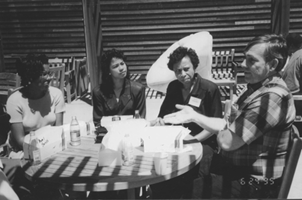
left to right: Janine Anthony, Tasha Inniss, Sylvia Bozeman, and
Robert Megginson.
I felt that it was great to see that there are others out there who are going through things that I am.
I met grad students from everywhere! I did not know that there were so many.
Successes: meeting people who could help me attain my goals of becoming a Ph.D. in mathematics. Gaining inspiration from those who have succeeded.
Some of the comments suggested things that participants seem to miss in their home environments.
The important aspects to me were being informed on the current research topics and issues in the mathematics world, and being part of a forum in which Ph.D.s and aspiring Ph.D.s could talk in a relaxed environment.
... speaking with others in my field that I felt were interested in what I had to say.
... the diversity of the talks and the interactions (conversational opportunities) with people, the math community.
... I was comforted to see such a wonderful support system for young African American students pursuing graduate studies.

Hearing the work of other black mathematicians and meeting with students in a friendly supportive atmosphere.
Almost everyone complimented the speakers, staff, and members at MSRI for their availability for informal discussions.
Yes, everyone was accessible.
Yes, there were many opportunities to talk to the speakers and members of MSRI.
Plenty!! Everyone made themselves available.
I had numerous opportunities to speak with the other participants. The informal atmosphere offered many chances to interact with the speakers and organizers.
![]()
How This Conference Came to Be
In September of 1994 Bill Massey and James Turner discussed mutual concerns about issues facing African American students and researchers in the mathematical sciences (see the Notices, May/June 1994, p. 448 interview with Turner) in the context of a recommendation by the AMS Committee on the Profession to create a task force to recommend steps that the AMS could take to increase participation in mathematics by minorities. Massey described conferences organized by groups like the National Society of Black Physicists in which groups of minority researchers presented and discussed their research with other minority researchers and suggested that an analogous effort was needed in the mathematical sciences.
In October of 1994 Turner and I met several African American graduate students who asked for assistance. For the last four years the National Association of Mathematicians has sponsored an Undergraduate MathFest at a historically black institution which brings together undergraduate mathematics majors interested in learning about graduate work in mathematics. A few graduate students are invited to share their experiences and inform the undergraduates from a student perspective. Some of the graduate students at the program in Greensboro, NC, last October described feeling isolated in their graduate programs and asked what the community could do to help them. The students from Georgia Tech deserve special credit (Greg Allen, Sherri Burgman, Jimmie Davis, Chenita Hampton, Tasha Inniss, and Michael Keeve) for raising an important issue. They pointed out that current graduate students have already made a commitment to mathematics, yet the community was doing more to attract new students to mathematics than to help those embarked on a career in mathematics.
In November 1994 Bill Thurston expressed an interest in having MSRI help with graduate pipeline issues, and a group of minority mathematicians met at MSRI in January 1995 during the San Francisco AMS meeting to discuss what could be done. Bill Massey, James Turner, and I were encouraged to organize a conference as an initial means to get minority and nonminority mathematicians together (through mathematics) to think about what should be done to develop minority mathematicians. Bill Thurston volunteered MSRI as the host institution, James Turner supplied considerable funding from grants, Bill Massey convinced AT&T Bell Laboratories' officials of the value of such a conference for students participating in the AT&T Cooperative Research Fellowship programs, and this conference was the result.
![]()
Words cannot truly capture the spirit of excitement and camraderie that marked this conference. Even the sum total of the talks, the discussions, and the many photos will not capture the essence of the experience. For three days everyone was able to function as a valued member of a community with common scientific interests and common concerns.
I was extremely impressed with the growth and professional development shown by the graduate students during the conference. They participated fully in all parts of the program, chairing sessions and introducing speakers. They learned after arriving at the conference that this was planned, and enthusiastically volunteered. They made good suggestions during the discussions and communicated with working mathematicians as professional colleagues. They contributed to a lively question and answer period after each talk.
The graduate students' desire to acknowledge mathematical mentors highlighted for me a critical role played by members of the mathematics community that is not always given the attention it deserves. Mentoring can be critically important to minority mathematicians. We will work to establish cross-institutional mentoring arrangements to sustain community members (undergraduate students, graduate students, postdocs, and junior faculty members, in particular) during the long year.
Lee Lorch, a veteran conference attendee, has seen the mathematics community move from a segregated one to a more open, if not always welcoming, community which is now grappling with the alarming and systematic backlash that threatens the few gains that have been registered. He commented that ``I have never seen a more diverse conference: there was diversity of research interest, diversity of the type of school represented, substantial numbers of women who were active participants at all levels, diversity of age, diversity of career level.'' There was a strong sense of caring about each other's welfare and concern for advancing the common good, even when there were differences about what needs to be emphasized in service of the common good.
I worry about what will happen when participants return to their home institutions and their relative isolation. They will attempt to apply the lessons they have learned from this conference, but the response will not always be positive. We have set up an electronic listserv for participants and others interested in the issues which we hope will help keep contacts alive (aarms@lists.colorado.edu; if interested send a message with ``subscribe AARMS YourName@address'' to listproc@lists.Colorado.edu).
The inspiration gained from this conference will wear off in a finite time, but the mathematics learned will last forever.
![]()

left-to-right: Shabbazz, Blackwell, and Wilkins
Gregory Allen, Georgia Tech; Janine Anthony, Clark Atlanta; Louise Brown, Georgia Tech; Sherri Burgman, Georgia Tech; Cyril Coumarbatch, Rutgers; Jimmie Davis, Georgia Tech; Jonathan D. Farley, Oxford; Kimberly Flagg, Maryland (College Park); Chenita Hampton, Georgia Tech; Illya Hicks, Rice; Regina Hill, Rice; Flory Holmes, Arizona State; Rudy Horne, Colorado; Atiya Hoye, Maryland (CP); Greg Huber, Berkeley; Tasha Inniss, Georgia Tech; Otis Jennings, Georgia Tech; Willette Johnson, Virginia Tech; John Jones, Maryland (CP); Perpetua Kessy, Maryland (CP); Martin Khumbah, Virginia Tech; Mark Lewis, Florida State; Alice Livingston, Northern Illinois; Bethuel Mbugua, Harvard-Westlake; Tyrone McKoy, Maryland (Baltimore County); Cassandra Moore McZeal, Rice; Milton Nash, Princeton; Marcus Neal, Princeton; Rosa Perez, Hunter College; Errol Rowe, Maryland (CP); Regis Smith, Berkeley; Idris Stovall, Virginia Tech; Robert Thrash, Carnegie Mellon; Gikiri Thuo, Maryland (CP); Darrin Vissaraga, Texas (Austin); Frankie White, Texas (Austin); Donald Williams, Rice; Pamela J. Williams, Rice; and Michelle Wilson, MIT.
Darry Andrews, AT&T; Earl R. Barnes, Georgia Tech; David Blackwell, Berkeley (ret.); Lenore Blum, MSRI; Robert Bozeman, Morehouse; Sylvia T. Bozeman, Spelman; Danielle Carr, Bryn Mawr; Duane Cooper, Maryland (CP); Darryl Corey, Norfolk State; James Curry, Colorado; Nathaniel Dean, AT&T; James A. Donaldson, Howard; Amassa Fauntleroy, NC State; Arthur D. Grainger, Morgan State; Isom Herron, RPI; Donald Hill, Florida A&M; Johnny L. Houston, Elizabeth City State; Fern Y. Hunt, NIST; Raymond L. Johnson, Maryland (CP); Donald R.King, Northeastern; Joshua Leslie, Howard; Lee Lorch, York (ret.), Dawn Lott-Crumpler, Maryland (CP); Carolyn Mahoney, Cal State San Marcos; William Massey, AT&T, Eldon McIntyre, AT&T, Camille McKayle, Lafayette; Robert Megginson, Michigan; Walter Miller, Howard; Asamoah Nkwanta, Howard; Kevin Oden, Harvard; Michael Odyniec, Hewlett-Packard; Arlie O. Petters, Princeton; Carl Prather, Virginia Tech; Abdulalim A. Shabazz, Clark Atlanta; Peter Szego, Cal State Senate (ret.); Charles Thompson, Lowell; William Thurston, MSRI; James Turner, Florida A&M J. J. Ernest Wilkins,Jr., Clark Atlanta; and Roselyn Williams, Florida A&M. [note]
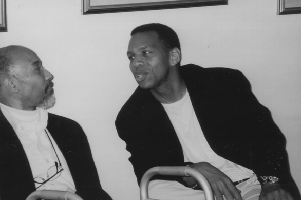
Eldon McIntyre and Kevin Oden
![]()
Abstracts of Presentations at the Conference
![]()
Real Zeros of Random Polynomials
J. Ernest Wilkins,Jr., Clark Atlanta University
We present a survey of results that estimate the mean value of the number of real roots of an algebraic polynomial of degree $n$ when the coefficients of that polynomial are random variables and $n$ is a large integer. Of particular interest is the special case in which the coefficients are independent, normally distributed random variables, each with mean $0$ and variance $1$, although we will discuss some results for several other coefficient distributions. In all the cases considered, the mean number of real roots is $O(\log n)$, so that there are relatively few real roots. We also mention the small number of results known for estimating the variance of the number of real roots. We then consider analogous issues for trigonometric cosine polynomials of the form, $a_1 \cos x + a_2 \cos 2x + \cdots + a_n \cos nx$, and estimate the mean number of zeros of this polynomial that lie in the interval $(0, 2p)$. In contrast to the algebraic case, this mean number is $An + o(n)$ for some constant $A$ that depends on the coefficient distribution
![]()
Singularities in Gravitational Lensing
Arlie O. Petters Princeton University
Light rays are the carriers of practically all observational facts we know about the universe. Consequently, an understanding of how light rays are affected by the gravitational influence of matter along its path is of great physical interest. This is exactly the focus of the theory of gravitational lensing.
During the past fifteen years, the subject of gravitational lensing has matured into an area where empirical observations, physical theories, numerical simulations, and the mathematics of singularity theory all converge. Today, gravitational lensing stands as an important offspring of Einstein's general theory of relativity and is one of the most vibrant and rapidly growing areas in galactic and extragalactic astronomy.
This talk will show that singularity theory provides a rigorous and natural unifying framework for gravitational lensing's central physical ideas, strengthening and advancing it theoretically. Several applications of singularity theory to the study of multiple imaging, image magnification, and caustics will be presented. We shall also discuss singular and nonsingular gravitational lenses, as well as compare single and multiplane lensing.
![]()
Analyzing Incomprehensible Networks
Nathaniel Dean, AT&T Bell Laboratories
Networks are often used to represent relational systems of discrete objects such as communications systems, entity-relationship diagrams, and proximity data. A variety of graph theoretic tools have been developed to explore such systems. This talk gives a broad survey of graph theory motivated by a variety of solved and unsolved problems in the analysis of networks.
![]()
Danielle D. Carr, Bryn Mawr College
Mathematical biology is the study of the life sciences that uses mathematical models to help predict and interpret what we observe. My research can be broken into two distinct areas. One is based on the mathematical model that governs the transport system inside the nerve cell. This gives rise to a reaction-hyperbolic system of PDEs for which global existence of solutions is proven. The second area involves a computational method used to describe swimming of the lamprey fish. This method solves the Navier-Stokes equations for viscous, incompressible fluids. This study will be useful in determining the fundamental properties of neural networks that govern involuntary rhythmic behavior of vertebrates.
![]()
What Is Ergodic Theory and What Can It Tell Us About Dynamical Systems?
Fern Y. Hunt, National Institute of Standards and Technology
This presentation is intended for an audience of mathematicians working in other fields who might wonder why they should listen to a talk in the area of ergodic theory of dynamical systems. Our purpose is to show that invariant measures can give precision to our intuitive sense of a ``distinction'' between randomness and deterministic behavior. In particular we discuss how the pioneers of this field, H. Poincaré and E. Hopf, developed a coherent framework for investigating the emergence of randomness in erstwhile deterministic systems. As an example, we discuss the coin tossing problem, as analyzed by J. Keller and extended by P. Diaconis and E. Engler. The statement that the probability of tossing a coin and having it land on a surface showing heads is 1/2--stated so easily and assented to so quickly in a probability class--is true because the randomness of the coin arises from imprecision or uncertainty in the initial position and velocity of the coin. The value of 1/2 is not a consequence of the coin's symmetry but is a limiting value that is approached as either the initial vertical or initial angular velocity of the coin is large--as it is in practice.
With this motivation, we go on to discuss the author's recent work on invariant measures of finite dimensional maps. Just as the value 1/2 reflects the long time behavior of the coin's motion, so the invariant measure of an ergodic map reflects the limiting distribution of possible positions after iterating a point for a long time. The ergodic theory point of view allows us to consider the possibility that the initial position of this point is uncertain. Rather than study maps directly we consider maps perturbed by white noise instead. Proving properties like ergodicity of invariant measures even with special conditions on the map is hard, thus we look at the invariant measures of nearby maps hoping that they can tell us something about the invariant measures of the unperturbed maps. Hence the amplitude of the perturbing noise is assumed to be small. We show that under mild contraction conditions for the map, there does exist a unique invariant measure which is approached exponentially under iteration, starting from an arbitrary initial distribution of positions. Thus points iterated by the random map will at large times have the same distribution, whose support we may associate with the attractor of the randomized map.
![]()
Bandlimited Signals, Quantum Mechanics and Sampling for Entire Functions
Carl Prather, Virginia Polytech Institute
First, the Whittaker-Shannon cardinal series for bandlimited signals will be derived with applications given to nonharmonic Fourier series. Secondly, a classical completeness problem for Fock-Gabor coherent states arising in quantum mechanics will be introduced. The solution of these problems involves the use of expansion results for functions in the Bargmann space of analytic functions, as will be explained.
Each of the above topics makes use of sampling theorems for entire functions. Some recent work connected with wavelets will be outlined with generalizations and open questions indicated.
![]()
Rethinking Queueing Theory to Model Time-Varying Behavior
William Massey, AT&T Bell Laboratories
Queueing theory has its origins in the performance modelling of telecommunication systems, starting with the Erlang loss model developed in 1917. This led to the classical Erlang blocking formula which is used to this very day to estimate the frequency with which all circuits are busy in a telephone trunk group for a given average call arrival rate, average conversation rate, and fixed number of telephone trunklines. Such formulas were obtained through the then emerging probabilistic theory of Markov chains. Although queueing theory has evolved considerably over the decades, relatively little work has been done in the area of queueing systems whose average arrival and service rates vary over time. Whereas it is clear that systems with time-varying rates are more realistic, analyzing the resulting mathematical model is considerably more difficult.
In this talk, we will introduce both the classical Erlang queueing model and its time-varying analogue. First, we will show how we must reassess what are the most appropriate mathematical techniques for analyzing this time-varying model and formulate new approaches. In addition, we will see how we must also rethink what are the most appropriate performance metrics for the underlying telephone system that is being modelled. Finally, we will highlight the intimate relationship between modelling and estimation assumptions with the creation of a mathematical framework of theorems for a time-varying queueing theory.
![]()
Partial Differential Equations and Spectral Geometry
Kevin Oden, Harvard University
Spectral geometry is an enormous field which one might say began in earnest with the still fascinating two volume Theory of Sound by Lord Rayleigh. The basic problems deal with determining the relationship between the geometry of the vibrational medium and its vibrating frequencies (eigenvalues), which is the now famous conjecture of M. Kac: ``Can you hear the shape of a drum?'' In recent years this question has been answered in the negative. That is, there exist nonisometric domains which are isospectral. However, there are still many important questions to ask. For instance, to what degree can one understand gaps between eigenvalues? What are the topological and/or geometric constraints on eigenvalue gaps?
There is also a notion of ``frequency'' associated with a graph. One can define a discrete Laplace operator, which in the limit (when also suitably) defined is the continuous analogue. Then, we may ask the same questions in the discrete setting.
In this talk we will give some physical background for eigenvalue problems and then sketch some joint research with S. Y. Cheng on eigenvalue gaps on domains in Euclidean space. We will then discuss the analogous problems in the discrete setting (joint research with F.R.K. Chung).
![]()
Mathematical Problems Arising in the Study of Smart Materials
James C. Turner, Jr., Ohio State University and Central State University
The smartness of a material is a consequence of its ability to form a flexible structure at one temperature or load while recognizing only a homogeneous equilibrium at a different temperature or load. These materials include shape-memory, magnetostrictive, and other active materials and are finding increased applications as actuators and sensors and inherently, they are highly nonlinear.
The mechanism leading to shape-memory behavior relies on a displacive transition or a temperature controlled change in shape. This is the hallmark of a martensitic transformation and it is frequently accompanied by a complicated microstructural pattern. A major challenge to materials science is the prediction and control of microstructure. In recent years a theory of microstructure has been developed and put into practice that can describe the macroscopic properties of martensitic, shape-memory alloys. Mathematical models for the equilibrium of such materials give nonconvex variational problems that may fail to attain a minimum value for any admissible deformation.
It is my intention in this lecture to introduce several important nonlinear techniques developed in recent years for studying mathematical problems arising in materials science. We will discuss some of the first numerical simulations of equilibrium states for martensitic crystals. These numerical simulations have presented many new and challenging problems. In addition, we will describe a research program that has as its goal the development of a continuum theory and a computational model able to predict some of the behavior of shape-memory materials under the influence of loads, boundary displacements, and temperature changes.
![]()
The Formation and Properties of Shear Bands in Viscoplastic Materials
Dawn Lott-Crumpler, University of Maryland at College Park
Shear bands, which are localized regions of high strain, form in ductile materials as a result of severe plastic flow. The formation of shear bands occurs in a variety of materials; i.e., polycrystalline structural metals, rocks, ductile single crystals, polymers, and other solids. These shear bands, triggered by inhomogeneities in the material, signify the possibility of further deformation and are often the precursor to failure. Shear bands may denote weak areas or areas of plastic flow and are accompanied by strain rates which are orders of magnitude higher than strain rates found in the undeformed portion of the material.
We employ an adaptive Chebyshev pseudo-spectral method for the numerical computation of shear bands in one and two dimensions. The method allows very high resolution of the spatial structure of the band and is used to study both the dynamics of band formation and its spatial structure with special emphasis on the role of imperfections.
![]()
Chaotic Behavior of the Affine Scaling Algorithm for Linear Programming
Earl R. Barnes, Georgia Institute of Technology
This talk will contrast interior point methods for linear programming with the simplex algorithm and show some advantages for interior point methods. We will also show some unexpected behavior for interior point methods. These methods are nonlinear approaches to linear problems. Accordingly, they can exhibit some of the complicated behavior associated with nonlinear dynamical systems. We will show examples of bifurcating solutions, chaos, and fractal patterns generated by these methods.
![]()
Dirichlet-Neumann Operators and Evolution Equations
James A. Donaldson, Howard University
Let $U$ be harmonic in $D$, a simply connected region in $n$-dimensional Euclidean space with smooth boundary $C$, $f$ be the restriction of $U$ to $C$, and $g$ be the outward normal derivative of $U$ on $C$. A Dirichlet-Neumann operator is an operator that maps $f$ to $g$. Various properties of these operators and their generalizations are considered. In a Hilbert space, an initial-value problem for a second order differential equation involving a special class of these operators is investigated.
These results play a key role in the establishment of the linear ``shallow water'' theory. This theory provides an important example of the approximation of the solution of an initial-boundary value problem for an elliptic partial differential equation by the solution of an initial-value problem for a hyperbolic partial differential equation.
This is joint work with Daniel A. Williams.
![]()
Since opening 5/25/97,
visitors to
These web pages are brought to
you by
The
Mathematics Department of
The State University of New York at Buffalo.
created and maintained by
Dr. Scott W. Williams
Professor of Mathematics
CONTACT